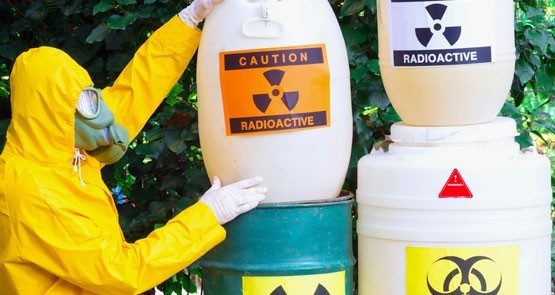
Last week the preliminary findings from the Royal Commission into the Nuclear Fuel Cycle handed down by commissioner Kevin Scarce in South Australia indicated that the development of a high-level nuclear waste dump would bring in billions of dollars and create thousands of jobs.
Both major parties will await the royal commission’s final report before formally responding, but neither has ruled out support for a waste dump in the state. But what is the proposal, and why do we need a waste dump in South Australia? And who are the loudest voices in this debate?
What would the proposed dump store?
The proposed dump would be the storage facility for the high-level nuclear waste from other countries that use nuclear power, which Australia does not.
We produce nuclear waste from using radioisotopes in medicine, research and industry, which needs to be stored somewhere, but the main use of the facility would be to store the hundreds and thousands of tonnes of high-level waste from nuclear power stations that are in temporary storage around the world.
Why South Australia?
In the last few years, South Australia’s economy has struggled. According to CommSec’s January 2016 state & territory economic performance report, South Australia is the seventh-ranked economy in the country (only Tasmania is worse).
The tentative findings from the report suggest the project could generate $257 billion in revenue. Additionally, the report found about 1500 jobs would initially be created and this would rise to 4500 jobs during a construction period of 25 years.
The report believes this nuclear waste dump could be crucial for economic growth in South Australia for many years to come.
What is the difference between high-level and low-level waste?
High-level waste, of the type that would be stored at the facility, is highly radioactive. The waste often includes materials produced as a by-product of reactions that occur in nuclear reactors. The only way that radioactive waste becomes harmless is through decay, which, for high-level waste, can take hundreds of thousands of years in storage.
Low-level waste includes items or materials that have been contaminated with radioactivity, such as materials like tools and clothing from power plants.
Is storing nuclear waste dangerous?
That depends on how you define dangerous. There is an element of risk involved if the correct safety procedures are not maintained — and keep in mind, these safety standards must be maintained for hundreds of thousands of years.
However, countries like the UK, France, Spain and Japan all have near-surface disposal facilities for low-level waste. Currently, Finland and Sweden are building their own high-level waste dumps.
To put it simply, a high-level waste dump below surface is the safest way we can possibly store high-level waste and keep society protected from radioactivity.
Who supports the proposal?
At this stage, it looks like the plan has the backing of quite a few state and federal MPs.
At the federal level, Opposition Leader Bill Shorten gave tentative support for the proposal last Tuesday:
“Federal Labor has always said we do support safe storage of low-grade nuclear waste.
“We need a sensible analysis … we’ve got to make sure the numbers stack up, the environmental safeguards stack up and the community supports it.”
Similarly, Resources Minister Josh Frydenberg told The Australian the plan was “a very significant economic opportunity” for South Australia:
“This requires a bipartisan approach … there will be more consultations to take place.”
Locally, South Australian Premier Jay Weatherill penned an article in Adelaide’s Advertiser, arguing that it was time for serious debate about the issue, and for South Australians to seriously consider the commission’s findings:
“This week’s finding of the Royal Commission is just the start of the process of coming to a community view and it is worth underlining the reason for choosing the royal commission process.”
Additionally, state Labor MP Tom Kenyon has been a vocal supporter of the dump, telling Crikey it would provide much-needed economic growth for South Australia.
“We are only 7% of the country’s population, we are 14% of the country’s land mass, and with that it means we have smaller tax base to support a large area,” he said. “We can only progress at a certain speed.”
Kenyon acknowledges that there is an element of risk with the proposal, but he is confident that the state can meet required safety standards.
“Of course, there is certainly an element of risk, but there’s an element of risk when you jump in the car to drive down to the shops,” he said.
South Australian opposition leader Steven Marshall is at this stage remaining neutral, saying the Liberals will wait until the final report is released before offering bipartisan support for the dump.
Who doesn’t?
Unsurprisingly, the commission’s findings are facing their fair share of opposition from environmental groups.
South Australian Greens MP Mark Parnell told Crikey the report’s findings were “no surprise”, but he was sceptical of the jobs and revenue projections.
“The only surprise was the numbers. They told wealth for all, which I think, are based on heroic assumptions and a lot of guess work,” he said. “We will be doing our own analysis of the figures and we are confident that these figures will be unreliable.”
Parnell went on to say that he believes it’s important South Australians do not see this as the only way to ensure the state strengthens its economy in years to come.
“No one wants to host the world’s nuclear waste. The problem is that some people think we have no choice. But South Australia is better than that. We have a bright future, and we aren’t desperate,” he said.
Friends of the Earth’s anti-nuclear campaigner Jim Green also told Crikey he had “little faith” that safety standards could be maintained at a level that society needed for an extended period of time.
“It’s about longevity — longevity of maintaining these standards over hundreds and thousands of years,” he said.
Another central part of this debate, he says, is the nuclear industry’s treatment of Aboriginal people.
“If this dump is to go through, the government will face ferocious opposition from the traditional owners of the land,” he said.
When will a decision be made?
The final report isn’t due until May, so the federal parties won’t make up their minds until after that.
One thing that does bind those on both sides of the debate is that the dump will have to have significant community support before it is approved.
“I do agree with commission on one thing and that is ultimately this is a decision for the people,” Parnell said.
Meanwhile, Kenyon believes South Australians are “certainly interested” in the report’s preliminary findings.
“They haven’t turned off, they want to listen to the debate,” he said.
A decision won’t be made until the end of the parliamentary year, according to Parnell, which means both sides have “many months to have this debate”.








Interesting that we must have a “plebiscite” on marriage equality, which harms no one, but only MPs assessing the almighty risk of storing high level waste in South Australia. South Australia is not a basket case but it does have a basket case Government. This issue should be settled by young people. They will be at risk- not old people, because the facility if it goes ahead at the behest of our basket case Government (overly influenced by the nuclear industry), will not be in operation for another 10 years at least. Then someone will have to build the ships, trains and road transport that can carry the waste safely. People over 65 should not be allowed to vote or influence this debate because they will be dead.
Calling the stuff “waste” makes for a loaded question. The word can mean many things to many people, with only odium in common. To unthinking people, the best destination for waste is to burn it, so it all vanishes into thin air. That’s the greenhouse, to those who do. No one calls it “dumping”, although we should.
“Used fuel” would instead evoke the realisation that it can be used again. As fast reactors spread, (China plans 1400 GW by 2100) the value for recycling becomes enormous. That implies a repository, not a “dump”.
On the other hand Brangwyn, if old people, in their wisdom, vote against the dump and it never happens, young people will be the beneficiaries.
A new article on a much discussed issue that’s merely a regurgitation of trivia which makes no attempt to analyse the arguments.
Crikey at its standard level.
This is not just a “South Australia” issue. Ships carrying this waste will have to go near the East coast and the West coast. If one of these ships sink it will be a disaster for whichever state it is near. An Australia wide plebiscite is essential. SA has been awash with nuclear lobbying money – we can’t trust politicians with this decision.